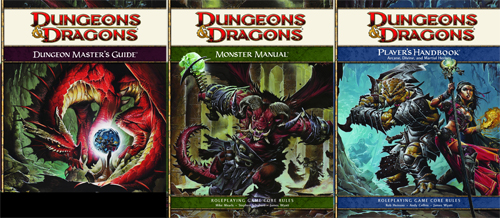

Cultural Slump and 4th edition
On August 15, 2007, Wizards of the Coast announced the development of D&D 4th edition. In December 2007, the book Wizards Presents: Races and Classes, the first preview of 4th Edition, was released. This was followed by a second book in January 2008 named Wizards Presents: Worlds and Monsters. The Player's Handbook, Monster Manual, and Dungeon Master's Guide were released in June 2008. Slashdot reported anger from some players and retailers due to the financial investment in v3.5 and the relatively brief period of time that it had been in publication.[20] Although many players chose to continue playing older editions, or other games such as Pathfinder by Paizo Publishing (itself based on D&D v3.5 via the Open Game License),[21][22] the initial print run of the 4th edition sold out during preorders, and Wizards of the Coast announced a second print run prior to the game's official release.[23] Unlike previous editions with just three core rulebooks, 4th edition core rules include multiple volumes of the Player's Handbook, Dungeon Master's Guide, and Monster Manual that were released yearly, with each new book becoming a part of the core.[24] In the first Player's Handbook, the warlock and warlord are included, while the barbarian, bard, druid, sorcerer and monk are not present. Of those classes, the first four were included in Player's Handbook 2, while the monk class appears in Player's Handbook 3. Mechanically, 4th edition saw a major overhaul of the game's systems. Changes in spells and other per-encounter resourcing, giving all classes a similar number of at-will, per-encounter and per-day powers. Powers have a wide range of effects including inflicting status effects, creating zones, and forced movement, making combat very tactical for all classes but essentially requiring use of miniatures, reinforced by the use of squares to express distances. Attack rolls, skill checks and defense values all get a bonus equal to one-half level, rounded down, rather than increasing at different rates depending on class or skill point investment. Each skill is either trained (providing a fixed bonus on skill checks, and sometimes allowing more exotic uses for the skills) or untrained, but in either case all characters also receive a bonus to all skill rolls based on level. A system of "healing surges" and short and long rests are introduced to act as resource management. Dieter Bohn, for The Verge, wrote: "Every few years there’s been a new version of D&D that tries to address the shortcomings of the previous version and also make itself more palatable to its age. [...] The third edition got a reputation (which it didn’t necessarily deserve) for being too complex and rules-focused. The fourth edition got a reputation (which it didn’t necessarily deserve) for being too focused on miniatures and grids, too mechanical. Meanwhile, the company that owns D&D had released a bunch of its old material for free as a service to fans, and some of that was built up into a competing game called Pathfinder. Pathfinder ultimately became more popular, by some metrics, than D&D itself"
